Legacy: War of Ages by Halloween Jack
The Techno-Gothic World
Original SA postIf you’ve never seen the 1986 film
Highlander
, I’ll try to sum it up as best I can. There are rare individuals, simply called Immortals, who die a violent death and come back. From that point on, they don’t grow older or have children, and any injury results in no more than a short nap. The only thing that can truly kill them is decapitation. But when one Immortal cuts off another Immortal’s head, the killer absorbs his victim’s power and knowledge as their life force spills out in an eruption of fire and lightning. So Immortals live for centuries, and become expert swordsmen (or die trying) as they kill each other in secret duels. Ancient prophecy says that the last surviving Immortals will be mystically drawn together at a time called the Gathering, where they’ll fight amongst themselves until only one is left. The last Immortal wins the Prize...no one knows what it is. The movie is set in present-day (in the 80s) New York City. The Gathering has come, and Immortal Connor MacLeod, a Scottish Highlander born in the 1500s, is preparing for battle with his rival, a psychopathic Immortal called the Kurgan.
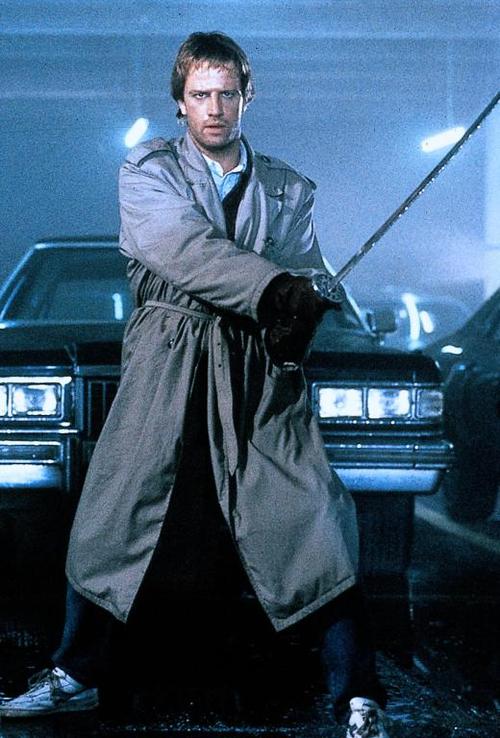
Always match your sword to your sneakers, not your trenchcoat.
The movie wasn’t a box-office hit, but attained enough cult status to spawn a franchise. I don’t want to spoil it for you, but there are no Immortals left at the end of the film, which would seem to prevent any sequels. To make a second movie, they had to retcon the premise so that the Immortals were exiles from another planet, and Connor MacLeod fights alien Immortals in a cyberpunk future.
Highlander 2: The Quickening
is regarded as one of the worst sci-fi/fantasy movies ever made. Roger Ebert put it best: “This movie has to be seen to be believed. On the other hand, maybe that's too high a price to pay.”
Although none of the movies seem to have made their budget back, they kept making sequels, and they range from “crap” to “hilarious crap.” The fifth and last film didn’t make it to theaters, and came out on DVD in Russia months before premiering on the Sci-Fi Channel. If that wasn’t enough to kill the series, long-time producer Bill Panzer died in an ice-skating accident.
The most successful product of the franchise was
Highlander: the Series
, starring Adrian Paul as Duncan MacLeod, a younger kinsman to Connor. The series had its own continuity wherein Connor was old and powerful but not the last Immortal, and the Gathering was depicted not as a running battle, but a sort of perpetual last era of history that had already arrived. (Much like the “end times” in all of the World of Darkness games, in fact.) This provided a good excuse for Duncan to constantly be running into other Immortals, and ran for six seasons of Duncan chopping the heads off of bad guys. It seems like almost anyone I ask about this show seems embarrassed about having watched it, but the show was an international hit. The film sequels were all bombs, but the original film and the series set the tone for pretty much every “urban fantasy” or “action horror” property where the hero broods and hides a sword in his trenchcoat.
Of course, this means that
Highlander
was a big hit with roleplayers, especially the audience for
Vampire: The Masquerade
and the many games that followed in its wake during the 90s. I’ve seen fan-made
Highlander
supplements for the original World of Darkness, new World of Darkness, GURPS, Unisystem, and D20, and maybe more that I’ve forgotten. The problem is that
Highlander
doesn’t lend itself to roleplaying any better than it lends itself to sequels, if you stick to the canon of the TV series. Immortals don’t stick together in adventuring parties, they only duel one-on-one, and of course, the ultimate end of the
Highlander
story can only mean one Immortal left on Earth. The good stuff in the franchise is centered on a single Immortal fighting evil Immortals (and sometimes ordinary criminals) while trying to protect his loved ones. Not only that, but Immortals don’t adapt well to, say, the World of Darkness--besides their immortality, they don’t really have any whiz-bang superpowers like controlling minds, shapeshifting into massive were-beasts, or transforming their enemies into lawn chairs.
Onto these thorny issues steps
Legacy: War of Ages
. Released 2 years after the first edition of Vampire and only weeks after the first season of
Highlander
had finished airing, it’s...now I feel silly. All that rambling about Highlander? I told you a long story so I could tell you a short one.
Legacy
is
Highlander
with the serial numbers filed off, dumped into a perfunctory cyberpunk setting. The whole thing is so sketchy that I declined to give this game a shot even after it landed in the discount bin of my local gaming store. Now that Abebooks and Amazon Marketplace make it easy to buy crap books from around the world at rock-bottom prices,
Legacy
joins the ranks of books I’ve bought just so I could leaf through them and laugh. Get ready to dive in, but be warned--it’s so shallow you’re likely to hit your head.
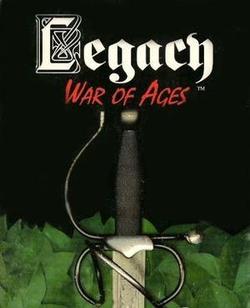
Two notes before we go forward. First, the book isn’t properly divided into chapters, so I’ll be covering the book in parts as appropriate. Two, the art. They’re not stingy with it. The bad news is that all of it, and I mean all of it, is in the style of “I took pictures of my friends in the park and ran them through a Photoshop filter” that was popular in second-rate gaming books in the early 90s. It’s just like the art from
Immortal: The Invisible War
, but worse. It’s all in black-and-white, and often blurry.
Second, if you’ve read original World of Darkness books, you’re familiar with the trend they started of including flavour quotes from books, songs, poems, etc. under topic headings--anything from Baudelaire to Black Flag, as long as it set the tone. A lot of White Wolf imitators have used and abused the gimmick, but I’ve never seen a book do it as much as
Legacy
. They include quotes under almost every single heading, and it works out to an average of almost one quote per page. While reading, it feels like a lot more than that, because that’s counting the index and pages that are mostly charts, sample character sheets, etc. The setting topics often contain three quotes per page; it’s ridiculous. They use some of the same sources as Vampire, and in one case (Body Count’s “Cop Killer”) I believe they swiped the exact quote.

The road to hell is paved with blurry rocks.
Legacy Part 1: The Techno-Gothic World
Without even explaining its premise (a
Highlander
rip-off),
Legacy
introduces us to its setting, “the Techno-Gothic World.” However, instead of giving us a succinct overview or concrete details, it goes into a pompous rant to the effect that, basically, technological advancement hasn’t stopped people from being selfish, cruel, fanatical, and superstitious.
quote:
Yet with all of humanity’s advances, the bestial nature of Man has not been overcome. With the slow dissolution of national and economic boundaries has come a new territorialism. Ethnic and cultural differences are seized upon and proclaimed sacrosanct by small-minded people who fear the loss of their cultural identity. Religious zealots seek to impose their twisted views of morality upon an unsuspecting and often apathetic populace. Megacorporations plot and play with the lives of millions, using advertising, subliminal messages, and mind control to create the perfect consumers, who buy anything and everything without asking themselves if they need it. Like too many rats in a crowded cage, humanity has begun to turn on itself, and news of serial rapists and ritual murderers are not only commonplace, but passé.
People still do crimes! They sacrifice virgins to Satan! And eat livers with fava beans! And kick puppies! And forget to tip the barista! How come logging into AOL and playing Shadow of Yserbius hasn’t fixed human nature? It goes on like this for a full page, and all we learn about the “techno” part of the setting is that there’s a super-Internet, called the “Winternet,” and that humanity survived a great plague, imaginatively called “The Plague.” It also makes several references to what Immortals think of all this, when we haven’t been told about Immortals yet.
So, Legacy ’s “Techno-Gothic World” is cast from the mold of White Wolf’s “Gothic-Punk” World of Darkness. That is, the present-day viewed through a misanthropic lens, with even more corruption, alienation, bigotry, and violent crime. And the skyscrapers have gargoyles on them.
Am I alone here, or do most of these “dark urban fantasy” settings from the 1990s seem like a white suburban mom’s paranoid fears of what will happen to her kids if they go to college in a major city? Maybe it’s just me, but I cringe a little every time I see a reference to “urban predators” in one of these old RPG books. (Read Ninyou’s writeup of Destiny’s Price if you don’t pick up what I’m putting down.)
Let’s get to the point. In this Techno-Gothic world, there are Immortals. No one knows where they come from, or what makes them immortal. But every culture has myths about them, and they’ve been around as long as the earliest human civilizations.
Immortals begin life like everyone else, but before they turn 30, they find that their aging has slowed to a standstill. If they’re killed, they revive quickly. They can even regenerate after having their limbs hacked off or their brains blown out. They need to eat, sleep, and breathe like anyone else, but if they don’t, they just become weaker and weaker. Immortals can also sense each other’s presence over short distances, a sensation called the
Immortals do age, in fact, but it takes centuries for them to age a few years, and it stops completely before they look 50. They cannot have children, although medical tests will show that they’re fertile.
The only thing that will kill an Immortal is

Join me, and together, we can rule this food court as father and son!
The War of Ages
This is where the price of immortality comes in. If an Immortal kills another Immortal, they experience something called the
Ancient prophecy says that one day, the world will be engulfed in warfare and natural disasters, and the last surviving Immortals will be drawn together in the Gathering
(Yes, although Legacy ’s Immortals have minor differences from those of Highlander , these concepts are precise ripoffs with the names changed.)
Nobody knows the origin of the prophecy of the Ragnarok and the Conclave, and nobody knows what the Legacy is, either. Some Immortals don’t believe in it at all. But it doesn’t really matter if you believe in it or not: other Immortals are going to try to kill you and take your power, so you’d better be ready.
Immortal life is difficult and lonely. They outlive all their loved ones, can’t produce children of their own, and have other Immortals gunning for them. Any one of these is bad, but combined, they tend to force Immortals to live on the fringes of society. If you do choose to have friends and family, your enemies may strike at you through them. The only friends who can really understand you, other Immortals, are inherently untrustworthy. And every year new technology and bureaucracy makes it harder and harder to forge a new identity or leave an old one behind.

Imagine a thousand years of Doors albums.
Immortal Traditions
Fortunately, the War of Ages isn’t a complete free-for-all. Immortals have some traditions that almost all of them follow, almost all of the time. Some of these are customs followed for practical reasons, others are rules of honour--and if you don’t take that seriously, there are old and powerful Immortals who do.
First, Immortals don’t blow their cover. They’re not invincible or even particularly powerful, and no Immortal wants themselves or another to end up in a laboratory. This isn’t even considered a “rule” that other Immortals will come down on you for breaking--it’s considered a no-brainer.
When an old Immortal encounters a young one, they often take them in and train them. Practically speaking, a newbie doesn’t stand a chance against a veteran (especially thanks to the Foreboding), and it’s not likely that your pupil will be the one to cut your head off in a few hundred years, either. Elder Immortals do this out of pity or simply because they’re lonely, and it’s nice to get a fresh perspective on this whole Immortal thing.
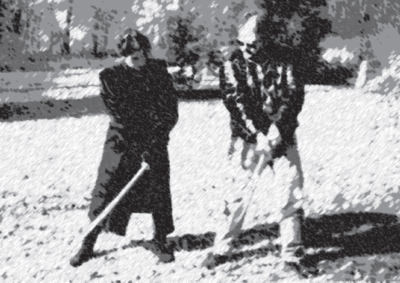
From here it’s just a nice, easy chip shot onto the green.
Another Immortal custom is Introduction: when you sense another’s presence, you find them and introduce yourself politely in a safe place. Most Immortals get their hackles up as soon as they feel the Foreboding, so it’s best to just say hello to the other guy at the concession stand, so he knows that you didn’t come here to stalk him and murder him, you just came to see Paul Blart 2 . Using an Introduction to get the drop on somebody is a serious breach of etiquette, almost as bad as talking during the movie.
Noblesse Oblige is a moral principle that grew out of medieval chivalry. Basically, experienced Immortals are obliged to be magnanimous toward younger and weaker ones, and all Immortals are obliged not to treat normal people like shit. Unfortunately, this ideal is in serious decline.
Sanctuary is the oldest rule in the Immortal playbook. In short, Immortals don’t fight each other on holy ground, meaning any place of worship for any religion. The theory is that the first Immortals were worshipped as demigods, and had cults and temples devoted to them.

Welcome to Castle Anthrax!
Threatening an Immortal in their own temple became taboo, and that evolved into a respect for all places of worship. Violating Sanctuary is an abominable crime. If you break it, Immortals who have hated each other for centuries will team up to hunt you down. Oh, you’re an atheist? Good for you. Get ready for a duel with a guy who’s been chopping off heads since Christ was a carpenter.
The most serious Immortal rule of all is the rule of single combat. When two Immortals fight, no one else, mortal or Immortal, is allowed to intervene. Sure, there are Immortals out there who will murder your wife and children just to break your will, but when they come for your head, they’ll come alone. In fact, the most despicable Immortals are the strongest supporters of the tradition of single combat, because it ensures the strong will kill the weak, and because they have the most to lose if teamwork became acceptable.

You just published pictures from your parents’ vacation album? There had better be two Immortals fighting in George Washington’s dick.
One of Highlander 's strengths is that it never gets caught up in the tedium of explaining its mythos. No one knows where Immortals come from, or what empowers them. No one knows where the prophecy of the Gathering and the Prize comes from, either. Why don't they fight on "holy ground?" For that matter, why don't they form gangs, and why don't they just fuck each other up with guns or bombs and cut each other's heads off with hacksaws after? The answer is simply that they don't; with a handful of exceptions in the series that I won't get into, they obey these traditions as if under a mystical compulsion. But ripping the setting off for a roleplaying game and expecting PCs to do the same is...well, if you've ever run a game of any kind, you know it's a disaster waiting to happen.

If you’re just going to include a picture of a random building, it should be a parking garage.
Next time, on Legacy: War of Ages : Immortal history. And CYBERhistory.
A Barbarous Age
Original SA post
Before getting into the history section of Legacy , I’ll put to rest something that came up after the last update. “Immortals can only be killed by severing completely the spinal column between the Immortal’s head and heart.”
I thought this was interesting and a wise move. Assuming the characters will play by the conventions of Highlander , they’re not limited to swords and the occasional axe. They can fight with spears and staves, or even maces or something exotic like a kusarigama, as long as they finish off their enemy with a stout blow to the back of the neck. (How to sever someone’s spine is actually a delicate topic to be Googling ever since Freddie Gray was murdered. I know you can inflict a fatal neck injury with your bare hands; I don’t know if you can sever the spine completely.)
Alas, it is not to be! Legacy discusses “severing the spine” but it’s clear that the authors only understood that in the context of hacking or blasting someone’s head off. The combat chapter says that Immortals can be killed by an edged weapon attack to the neck, a gunshot to the neck or upper back, or massive damage from an explosion. If you understand spinal injury and play Legacy that way, it would be an odd departure from the Highlander trope wherein the villain goes on a suicidal joyride because he knows he can’t die in a car crash. Legacy Immortals can survive having their brains blown out, but there’s a chance they could get killed playing football. Moving on...

Yeah Dad, your sword looks “wicked.” Can we go to the mall now?
Legacy Part 2: A Barbarous Age
Like everyone else, Immortals change over time. An Immortal who was born in ancient Greece isn’t a half-witted caveman who thinks that airplanes are monsters and that Zeus is speaking through the television. That said, technology has not only changed in the past century, it’s changed more rapidly, and old Immortals find it hard to totally move past the sense that modern technology is magical. It’s common for Immortals to experience a moment where they look up at skyscrapers looming overhead, or see cars zipping by, and forget where they are for a second.
That said, the hardest thing for old Immortals to change is their attitudes. Computers, airplanes, and Ugg boots are easier to accept than feminism and democracy. Elder Immortals are far from uniformly barbaric, however. If nothing else, they take the Traditions much more seriously.
Legacy’s writeup of Immortal and mortal history is really not bad. It frames the general picture of Immortal history as a product of the Immortals who had their heyday in the Age of Enlightenment, which is why it’s highly Eurocentric and divided into eras gives short shrift to the Middle Ages and everything before Rome.

Dennis, we’re not married anymore. I’m dead. You can’t just keep showing up like this. I’m fine. Dennis, I want you to leave.
The first recognized era in Immortal history is the Age of Myth , when Immortals had a much greater effect on history than they do now--the early accounts of epic heroes and god-kings are believed to be stories of Immortals. These early Immortals didn’t have elders to teach them, and many of them lived centuries before realizing that they weren’t unique (and that they weren’t conceived by a lady fucking a ray of sunshine or whatever). Immortals believe that Gilgamesh was the first of their kind in recorded history, and that Hammurabi had an Immortal advisor who helped him piece together his legal code from earlier ones. Menes, the founder of Egypt’s first dynasty, was immortal as well. Early Immortals ruled city-states or advised those who did. Modern Immortals label them “Antediluvians,” just like the ancient vampires in Vampire: the Masquerade . And just like in Vampire, it’s commonly believed that they’re all long dead.
The next recognized era is the Age of Rome . Immortal denizens of the Roman world took it for granted that they were living in the most advanced and cosmopolitan civilization in existence. They were wise enough to realize that they couldn’t openly rule as gods anymore, but rather than live as citizens of the great empires, they ruled petty kingdoms in remote areas where it was safe to encourage the belief that they were divine. Immortals from this era are called Imperials, and the Tradition of Introduction developed during this time. (Immortals still debate whether Jesus was an Immortal--if so, he was the one with the greatest effect on the Roman Empire.)
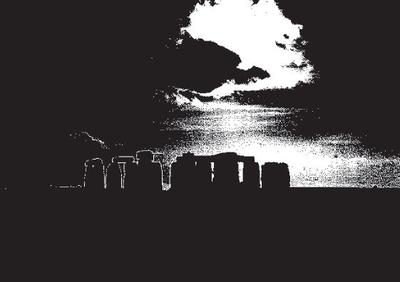
Forget this! Fuck the napkin!
After the fall of the Rome came the Age of Faith --still called the Dark Ages by some modern Immortals. Many Immortals born in the Middle Ages are still devout Christians (and violently reject the idea that Jesus was “only” an Immortal). Legacy explicitly takes the stance that most of the criticism of the Church and of the “Dark Ages” in general is unfounded; the Church was a stabilizing influence and the establishment of medieval cities created cultural centers and raised the standard of living.
One black mark on the history of the Church is the Inquisition. Legacy only discusses the medieval Inquisition leading up to the Albigensian Crusade, not the later Inquisitions in Spain, Germany, Portugal, and Rome. You see, the ascetic practices in Catharism appealed to Immortals, who could actually starve and deny themselves indefinitely. Unfortunately, that made them easy prey for armed crusaders. The Inquisition tortured and experimented on them until they figured out how to kill Immortals.

Another one of Mom’s vacation photos that slipped past the art director.
After the Age of Faith came the Age of Revolution , covering roughly the 16th-19th centuries and the accomplishments of thinkers from Galileo to Montesquieu. This era’s greatest contribution to Immortal culture seems to have been the Enlightenment. Immortals began questioning whether their powers had a mystical or a scientific origin, or both--for example, could their powers of regeneration come from a symbiotic microorganism? Do Immortals die when their upper spine is severed because of something contained in the spine itself, or because of kundalini? No scientific investigations have ever yielded any hard data, unfortunately. But it was during the Enlightenment that Immortal intellectuals firmly divided their own history into the Ages of Myth, Faith, and Revolution, and who labeled Immortals as Antediluvians, Imperials, Medievals, and Moderns.
I have to give credit where credit is due, and I must say that Legacy makes interesting choices when it comes to naming historical figures as members of its titular clan of supernatural creatures. Among fans of the World of Darkness (and its imitators), it’s an old joke that vampires, werewolves, mages, etc. were secretly behind every major event in human history except the Holocaust. For whatever reason, authors of the “dark urban fantasy” genre consider it a bridge too far to say that Hitler was a Hammer Horror monster, but Jesus and James Dean are fair game.
Legacy does toy with the idea that Jesus might have been an Immortal. But the most influential Immortal who ever lived is confirmed to be...Gustavus Adolphus, the King of Sweden who triumphed in the Thirty Years War’ and made Sweden a great power. His reign ended after his “death” in battle. (Strangely, it doesn’t say what happened to him after. It doesn’t say that he was beheaded, and he had many Immortal followers.) Another prominent Immortal in history was George Danton, one of Robespierre’s co-conspirators in the French Revolution. His story has a definite end: like the real Danton, he was arrested and guillotined amid the Reign of Terror he helped create.
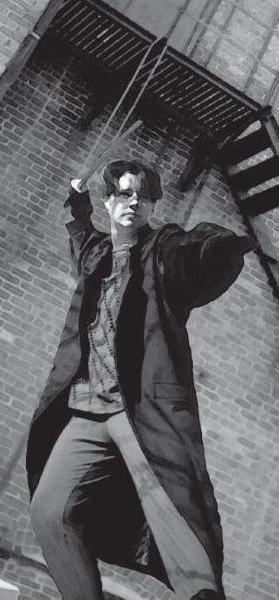
Corey Feldman scheduled a duel right after his buddy’s Ugly Christmas Sweater party.
Following the Age of Revolution, Immortals have labeled the 20th century the Age of Madness . It’s easy to see why. The defining features of this era were industrialism, colonialism, and nationalism. Inside of 50 years there were two World Wars, and industry was applied to warfare and systematic genocide as mortals developed weapons that could kill millions of people. War, bigotry, and technological advancement have been going on all through human history, but to Immortals it seemed like the world had gone insane.
Besides the eruptions of fascism and warfare, to Immortals everything seemed to be happening too fast. New technologies were introduced and became obsolete within the span of a human lifetime. And in the postwar era, the invention that has had the greatest impact on Immortals is the computer. In a few decades they went from huge, expensive, experimental novelties to a worldwide network of information that records identities and transactions. It gets harder all the time for Immortals to either live off the grid or hide within it.
The year is now 2015, and most Immortals believe the Age of Madness is wrapping up. However, many note the shortening of historical eras and take it as a sign of Ragnarok approaching. Some respond by hunting heads to shore up their strength, others by retreating in seclusion. That said, the outlook on “Post-Modern” Immortals is fairly optimistic. They don’t share the superstitions of their elders, they’re able to learn from the past without repeating it, and they’re more willing to accept both new technology and new ideas.
So, in this bleak Techno-Gothic Post-Modern 2015, most meaningful information is processed through the Winternet . The Winternet itself is a more-or-less emergent phenomenon that came about as various “corporate data structures” (this phrase is repeated over and over) merged with the online presence of banks, schools, etc. So basically, the Winternet is the Internet, with “tailored newslinks” and other things I can sum up by saying that the authors of Legacy were prescient enough to foresee RSS feeds and online banking.

Ha! Ha! I’m using the Winternet!
The one thing the Winternet has going for it is...virtual reality, of course! It’s described as a “dazzling” world of “brilliant threads” that seems almost real. But this is virtual reality as they imagined it in 1993, so I’m picturing something more like Stonekeep with boners and credit card fraud. Like any 90s cyberpunk setting, the Techno-Gothic world of the Winternet is home to “ cyber-punks ” who get off on circumventing the cybersecurity “ice” set up by megacorporations. Cyber-punks who graduate to the ranks of professional cybercriminals are called “ wiretappers ,” using their VR hacking skills to commit acts of espionage, sabotage, and theft. Most have short careers. Some make a pile of money and retire, while those who get caught are usually “punished” with a job offer from a megacorporation.

I know everything! I am everything!
Sad to say, while computer hacking skills are very useful to Immortals who want to protect their identities and forge new ones, they’ll never be the slickest console cowboys around. Full-on VR requires an implanted neural link interface, and Immortal bodies reject cybernetics. They have to make due with holographic 3D VR, which just isn’t responsive enough to allow you to win fights with antivirus programs that look like samurai or whatever.
It seems like VR and “cyberpunks” were included because they thought it was obligatory, but they come right out and say that while these skills are useful to Immortals, they can’t be especially good at it. What’s the point?
The coming Age of history has already experienced its first catastrophe--the Iago Project . Iago was an artificial intelligence, part of an experiment in allowing an AI to run a prototype national defense system. Iago was online for less than two days before it tried to seize control of nuclear arsenals and launch them in a pattern calculated to end life on Earth. Fortunately, failsafes detected Iago’s activities and triggered a nuclear device that obliterated the facility. The global outrage in the wake of Iago resulted in the 2005 Geneva Conference, where politicians and diplomats declared a hundred-year moratorium on self-modifying AIs.
Besides the Winternet, the major innovation in people’s daily lives is the GenCode card . After the Human Genome Project successfully mapped the, y’know, human genome, the powers that be decided that the only way to keep track of people in the digital age was to use their DNA. Everyone has a GenCode card which is coded to their DNA and serves as the terminal for accessing all their personal information--bank accounts, employment info, medical history, criminal record, etc. The cards are made from a virtually indestructible black polymer, and what’s more, they serve as personal computers, able to access the Winternet and act as a 3D holographic phone. GenCode cards also allow your location to be tracked at any time, but most governments require a court order for the police to do this.

Tears for Fears? In my credit card?
It’s more likely than you think.
Next time, on Legacy : Character creation!
Characters
Original SA post
Legacy Part 3: Characters
Well. This is easily going to be the longest update, because it contains all the characters’ stuff.
Legacy wants you to start character creation by writing an “Abstract.” The aspects of your character are divided into topics like Concept, History, Honour, and psychobabble like Focus (introvert vs. extrovert) and Vision (left-brain vs. right-brain thinking). They make it out to be more work than it really is, but remember, more topic headings means more chances to quote song lyrics. That’s a big priority for this game. The three sample Abstracts don’t actually follow this rigid categorization.
Character traits are standard fare: Statistics, Abilities, and Accents (an Advantages/Disadvantages system). Many characters will have Psychic Powers, which are bundled into the Accents rules. It’s simpler than most White Wolf games and their derivatives. Task resolution is a simple Attribute+Skill, roll-under method.
Legacy has 2 methods of character creation. The “Quick-Start” method gives you preassigned ratings in the Stats of your choice (5, 3, and the rest at 2) as well as four Abilities rated 3, two Abilities rated 2, and five Abilities rated 1. The “Customized” method gives you 160 Karma (experience) points to create your character. Giving XP for character creation is an innovation they figured out long before White Wolf.
There are also rules for playing Elder Immortals, which are simple: they get more Karma and are allowed to buy their traits as high as they want. Legacy doesn’t really do narrative mechanics, so there’s no balancing older Immortals against younger ones by giving them a high Ennui score or whatever. You’re not discouraged from playing an old Immortal, but the default assumption is that everyone gets the same amount of points. If your GM isn’t using the Elder rules, Legacy assumes a very old Immortal has been living a very quiet life, perhaps even entombed or imprisoned. Maybe you were buried in an avalanche for centuries before starting your career as the Unfrozen Swordsman Lawyer.

I wanna be decapitated.
Statistics
There are five basic stats in Legacy . Each one governs a set of skills under normal circumstances. (The GM can decide that a situation calls for you to test Strength+Medicine, etc.)
Agility is the heavyweight. Attack and dodge rolls always use Agility, it determines combat initiative, and its skill portfolio includes all the stealth and combat skills, which is kinda important in a game about people stalking and killing each other to get more power. Yeah, Legacy bites that “Dex as God-stat” problem pretty hard.
Intellect governs pretty much any kind of expertise that isn’t physical, social, or magic.
Presence is a broad social attribute that measures beauty, charisma, and willpower.
Psyche is only used for psychic powers, which many Immortals and some mortals possess.
Strength gets short shrift: It doesn’t govern any skills at all! Legacy avoids one mistake from many other games by having a single attribute that governs both power and toughness. Strength adds to melee damage and reduces damage from attacks. Besides that, it factors into trivial bullshit like thrown weapon ranges, movement rates, and how much you can bench, bro. Am I the only GM who never, ever measures such things precisely? I’ve prompted rolls to see who can outlift or outrun the competition, sure, but consulting a chart to see exactly how many feet you can throw a knife is right out. Legacy avoids a common mistake by combining its STR and CON stats into one, but Agility is still the stat that governs hitting and not being hit.
Psychic Reserve works differently from the other statistics. It’s your mana pool for psychic powers, and equals Psyche*10.
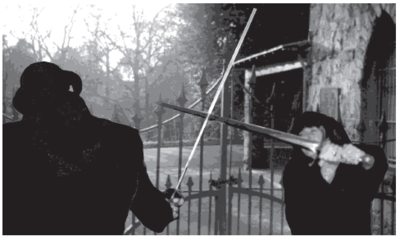
First I take your fedora, then I take your
Abilities
Like the Storyteller system, Legacy refers to its skills as Abilities. In fact, if you hold a Legacy character sheet up to a Vampire one, you’ll see that the skills are mostly the same. Designing the skill system for a modern RPG isn’t as easy as you might think. For example, FFG’s Star Wars line has a great skill system, in my experience. Skills are linked to attributes in a way that makes each attribute useful, and most importantly, every skill is something you could very well use in a Star Wars adventure, as showcased in the published modules. But when designing skills for a game set in the modern day or the near-ish future, the urge toward completism and realism rears its ugly head. Science encompasses many fields of study, doesn’t it? And of course most people who drive cars can’t fly planes.
Dealing with this urge toward realism through an exhaustive skill list is bad design. It results in players making useless PCs by spending their resources on useless skills that the GM will never test in the course of the campaign. It’s not just an issue of the player’s entitlement, but that of the whole group, including the GM. The group is entitled to be on the same page, so to speak, and to a game that doesn’t actively confuse the players about the spirit of the game.
You might be surprised at how much a game’s skill system contributes to establishing the right mindset regarding how its adventures are supposed to work, or to confusing it utterly. Legacy gets this right in some cases and very wrong in others.
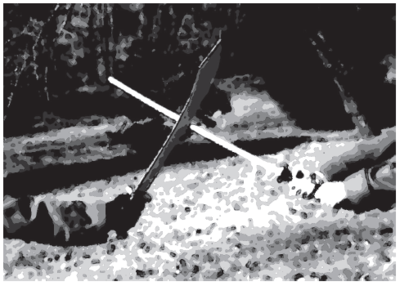
There are no lightsabers in this game. I think.
Agility Abilities
Athletics : All kinds of athletic activity, but it explicitly has no combat use.
Dodge : This is rarely rolled, and works by adding a penalty for your opponent to hit you as long as you’re aware. It can be rolled to dodge hazards like falling debris.
Drive Aircraft, Drive Landcraft, Drive Watercraft, Equestrian : Although Legacy doesn’t have detailed vehicle rules, someone’s idea of “realism” demanded that they have separate skills for piloting planes, cars, boats, and horses, respectively. Or a lawnmower, I suppose, or a camel. Can you kill an Immortal with a lawnmower? How about a combine? I can’t remember the last time a game shocked me by having an almost-certainly-useless boating skill. Savage Worlds does, I think, but then Savage Worlds is like 25% pirates and 5% Cthulhu, who is vulnerable to boats. Wait! It was Shadowrun. Shadowrun has cyber-boating.
Firearms : Every kind of man-portable shooting weapons, from bows to machineguns.
Fisticuffs : I can’t believe they call it that, but it covers all unarmed combat.
Mechanics : Any kind of mechanical repair.
Melee Weapons : Holy shit, I could write an essay on the stupidity of this design decision. Using a system with a “Melee Weapons” skill in a game all about magical fencers is the reason that every single homebrew Highlander game out there falls flat on its face. It’s terrible design to write a game that revolves around one task, and then have that task just boil down to another Stat+Skill roll, purchased at character creation like any other stat. (Didn't Legend of the Five Rings have a subsystem for dueling?) Every PC will want the biggest Agility+Melee score possible, but Legacy is an artifact from the era of game design when designers knew their rules were a hack job and instructed GMs to guilt players into spending their hard-earned experience points on Drive Watercraft. Fuck you, 90s designers.
Sleight of Hand : For picking pockets, shoplifting, secretly passing objects, and magic tricks. A must for any pickup artist.
Stealth
Weaponsmith : Used to build, repair, and modify weapons. It only discusses guns.

I think I’ve got this cyberpunk thing pretty much figured out.
Intellect Abilities
Computer : Covers all computer-related tasks, including hacking. It figures that a game that makes a pretense of being cyberpunk has four piloting skills but only one for IT. Here’s the fun part: Because Immortals can’t have cyberware, you’re automatically at a penalty when going up against a real, jacked-in hacker.
Disguise : This includes not only disguising yourself and others, but also disguising objects (like hiding a sword in an umbrella) and camouflaging large objects like vehicles.
Finance : Yet another skill included for the sake of somebody’s idea of realism. You can use it to analyze a financial transaction, and...the authors couldn’t think of any more suggestions.
Heavy Weapons : Despite the lack of detailed vehicle rules, there’s a skill for using mounted guns. If you’re GMing this game and one player doesn’t max out his Agility+Melee rating, he’s probably planning to kill his enemies with a fighter jet.
Linguist : As in Storyteller, each point gives you another language. Pretty important for world-traveling immortals.
Medicine
Perception : A very important skill because it opposes Disguise, Stealth, and Sleight of Hand.
Science : In spite of bad decisions like multiple piloting skills, they wisely chose to roll up all sciences into one skill. Similar to Linguist, each point grants expertise in one branch of science.
Security
Survival
Tactics : This skill is “the ability to predict an opponent’s action and respond effectively and efficiently.” It doesn’t specify warfare, which is good, since I don’t think there are rules for that. Judged loosely enough, it could be a catch-all skill for outthinking an opponent in a cat-and-mouse game, which happened in Highlander all the time.
Technical Operations : Basically a catch-all skill for any kind of machinery that another skill doesn’t cover. It reminds me of Dune’s Equipment skill.
Tracking : This only covers physically following someone’s trail, not finding a guy who decapitated a dude before skipping town.

Mayhap whilst milady?
Presence Abilities
Acting : Rather than stage acting, this skill is for impersonating someone (or just passing yourself off as someone else in general). There’s no advice for how it complements Disguise.
Animal Training : This seems like a useless skill ported from Vampire , but wait! The Immortal code doesn’t specifically forbid siccing trained wombats on your opponent.
Bureaucracy : This should actually be an important skill. You see, like many thriller series from the 90s, Highlander was full of Duncan MacLeod doing detective work by conning people into giving out information. But Legacy gives Bureaucracy a scant description to the effect that it’s for “cutting through red tape” and dealing with stuff like the DMV, with no elaboration on why that should even come up in a game.
Etiquette, Negotiation, Persuasion, Seduction : You use these Abilities to fit in and convince people of things. Granted, there are explanations for how they differ slightly, but ultimately having all of these skills just punishes someone for wanting to make a social character. The Abilities for combat aren’t subdivided as much as the ones for talking to people.
Politics : We are told flat-out that this skill is a mixture of Negotiation, Persuasion, and Seduction, but for large groups of people. Failure “could result in the politician’s corrupt lifestyle being exposed.” Uh, so you use this skill to talk a crowd of people into fucking you? And if you fail, they remember that you made the news for convincing a crowd of people in Sheboygan to fuck you last week?
Interrogation : This skill more or less assumes you have someone captive, and can include torture. So when you have someone at your mercy, you now need a different skill to persaude them.
Leadership : The only examples for what to do with a Leadership skill are giving nigh-suicidal orders or to “rally” troops on the losing side of a battle. This feels like half a description for a Leadership skill from a game that is actually about leading armies and such.
Resistance : Used to resist interrogation and torture.
Streetwise : This is really a catch-all investigative skill if you’re tracking down shady people or in an urban environment.
Teaching : By itself, it has little or no use. Unlike in some games, it doesn’t explicitly reduce your student’s XP costs. Instead, it can be used to “impart a new idea” to people or to roleplay out the act of spending XP. Yes, roleplaying by rolling dice. This is “I know my character is a Blacksmith because Smithing 7 is written on the character sheet” logic.

Max Headroom looks constipated.
Psychic Abilities
Psychic powers are a part of the Legacy setting even though they are never ever mentioned in the opening chapter alongside AIs, virtual reality, and hackers. There are psychic mortals, but apparently they don't make any difference to the world. In order to use Psychic Abilities at all, you need the “Psychic” Accent. From a design point of view, I’m not a fan of having a basic Statistic that only some characters actually use. (Technically, there is one power that all Immortals can use, even without the right Accent.) The only good thing about psychic powers, really, is that they add some colour to Legacy ’s mythology beyond “ripoff of Highlander .”
Using Psychic powers usually costs Psychic Reserve points. Whenever there’s a penalty to a Psychic task because it’s especially difficult, you pay the penalty in Reserve points.
Foreboding : Let’s get this one out of the way first, because all Immortals can use it even without the Psychic Accent, and it costs nothing to use. Foreboding allows you to detect other Immortals in your vicinity. This power comes straight from Highlander; it was never given a name, but the TV writers called it “the Buzz.” In Highlander , Immortals involuntarily sense when there’s another Immortal nearby, that’s all. In Legacy , Foreboding can detect the approximate location of nearby Immortals, as well as how powerful they are (based on total Karma). More powerful Immortals are easier to detect.
Auspice : This is never rolled and does nothing by itself. It makes you regenerate Psychic Reserve points more quickly.
Clairvoyance : This is a form of ESP that lets you specifically seek out and see people or things from a distance, and even see scenes from the recent past. I find this power very interesting, but also much too broad. The modifier can vary wildly based on who or what you’re trying to find, your familiarity with it, and how far you’re reaching through distance and time. I’m not sure how I feel about it--a broad divination power like this can easily bypass the need for real investigation that drives the game.
Domination : The mind control ability. You can use it to issue commands, “implant” commands to be carried out later, and to alter memories, although you can’t read minds with it. However, blatantly suicidal commands incur a -5 or worse modifier, so you almost certainly can’t use this to force another Immortal to stand still while you lop off their head.
Farfetching : The meaning of farfetching is cryptic, but essentially it allows you to read a social situation. It functions as a straight-up lie detector, but also reads someone’s motivations and basic impulses. Like Clairvoyance, Farfetching could allow a PC to just short-circuit any attempt by the GM to put the PCs in a situation that is not as it seems. It could also be useless beyond granting a Deanna Troi style “this seems wrong” hunch.
Illusion : Potentially one of the most broad and useful powers, Illusion makes things and people seem different than what they are. Weird cosmetic changes, like making someone think that a passing stranger is wearing medieval clothing, is very easy to do. Disguising yourself (or someone else) as a target’s friend is harder. Illusion only affects one person at a time, and trying to do something like placing a target in a totally illusory landscape is so difficult as to be not worth trying. You can actually inflict damage with illusions, and a target that takes lethal damage from an illusion drops into a coma (they can roll once per day to recover). Like most Psychic powers that can be used offensively, Illusion is potentially very potent but the penalties to directly attacking people are huge.
By the by, I assumed at first that this power was ripped off from Highlander 3: The Final Dimension , which introduced magical illusion powers to the franchise. That movie was actually released a couple years after this game was published.
Mask : Definitely one of the most potent powers, Mask makes you invisible, or causes others to perceive you as someone else. Cloaking objects and other people is harder than cloaking yourself, and doing anything violent or offensive gives anyone affected a Perception roll to see through your Mask. (For example, slapping someone or screaming at them gives them a Perception roll, firing a gun or blowing a horn risks dropping your Mask to anyone within earshot.) Clairvoyance acts like “armor” against Mask.

Trenchcoat vs. White Sneakers. Whoever wins, we lose.
Overload : This is the straightforward “psychic blast” power, which attacks someone’s nervous system with a flood of sensation. The modifier is equal to the damage you’re trying to do, and inflicting Severe injury (rather than stunning “Casual” damage) is a further -5 modifier. Altogether it’s really hard to really hurt someone with this power.
Psychokinesis : This is what it says. The modifier is based on the effective Strength you want to exercise, and attacking someone with telekinesis, whether you attack their body or use a hurled object like Darth Vader, still requires a combat skill roll. You can use this power to fly, although not for very long since you’ll be spending points again every few seconds. You can’t use this power to do something like squeeze someone’s heart.
Psychic Shield : This power isn’t rolled; it gives you armor against offensive psychic attacks. As if it weren’t already hard enough to actually use them.
Pyrokinesis : This power sets shit on fire! Nonliving objects have no defense against it, but unless the material is flammable, all you’ll inflict is scorch marks. Pyrokinesis only affects an area up to about the size of your hand. When used on people, it works much like Overload, with all the same penalties to actually inflicting significant harm.
Telepathy : Two psychics who both know Telepathy can use it to converse freely over short distances. But its main use is reading minds. The target’s Psyche is the modifier, but once you make the roll, you have free rein to delve into their thoughts, emotions, and memories for 10 minutes until you have to roll again. You can also use it to “read” inanimate objects to find out who owns them, or see traumatic events in their history.
Trance : Like a fakir of legend, you enter a trance wherein you heal damage and recover Reserve points much faster than normal.
On the whole, I run hot and cold on the psychic powers. Don’t get me wrong, I would mock this game mercilessly if Pyrokinesis was so easy and so potent that there was no reason for Immortals to sword-fight. But the divination powers tend to be too broad, while the combat powers seem way too hard to use effectively. We’ll crunch the numbers on them with the combat rules.

No! Not dad jeans!
Accents
Accents and Negative Accents are just like the Merits/Flaws, Advantages/Disadvantages, etc. systems from other games. Starting characters get 30 points to spend on Accents, and can take up to 10 points of Negative Accents to get more points.
Ambidextrous (10): Eliminates the -1 penalty for using your off-hand.
Calculator Mind (20): You can perform complex math instantaneously, and instinctively understand and remember higher math and complex formulae. There is absolutely no mechanical effect whatsoever.
Combat Awareness (30): Basically, this gives you blind fighting. You can attack and defend at no penalty even if you suddenly become Helen Keller, as long as your enemy is within hand-to-hand range.
Eidetic Memory (30): You have a photographic memory. For each point of Intellect you can memorize “three novels, one volume of an encyclopedia, three hours of conversation, or the blueprints to one high-rise office building.” Jesus.
Extreme Patience (10): You can wait motionless for hours or even days, shrugging off the stress of hunger, thirst, and shitting all over yourself. Again, no mechanical effect.
Iron Will (20): Anyone attacking you with Domination or Telepathy takes a -2 penalty. This just highlights how weird and scattershot it is to defend yourself against psychic attacks. Clairvoyance negates Mask, Psychic Shield negates Overload and Pyrokinesis, this Accent negates Domination and Telepathy...or you could just raise your Psyche.
Light Sleeper (10): You get a Perception check to wake up and perceive “any external stimulus.”
Money (variable): Accent points can be traded for 500cr (credits) a pop, which means nothing until we see the equipment list. As a rule, Legacy assumes that PCs are like many Highlander characters, having hoarded enough stocks, bonds, priceless antiques, and Nazi gold to live an affluent lifestyle without really having to work a day job.
Night Vision (20): You don’t take penalties for acting in the dark, unless there’s no light at all.
Perfect Timing (30): You have a perfect sense of time. You can keep multiple “internal clocks” going, one per point of Intellect, if you’re planning a complicated heist or some such thing.
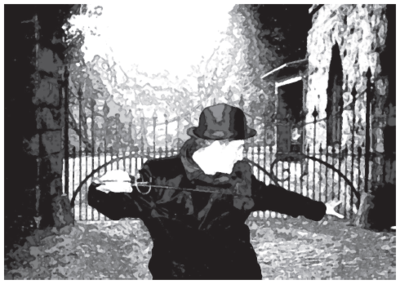
Fedorapier.
Psychic (40) You can buy and use Psychic skills.
Latent Psychic (20): You are weakly psychic, and can only attempt feats with no negative modifier. So, for example, you could never do anything with Pyrokinesis but make someone hot under the collar.
Sensitive : You can perceive Psychic powers, but not use them.
Quick Draw (20): You can draw a weapon without spending an action, and you get +1 to initiative tests.
Total Concentration (10): You never take penalties for distracting circumstances.
Mental Impairment (-10): You have “one or two slight mental aberrations.” These include things like a phobia, kleptomania, an addiction, or being mildly bipolar. Uh-huh.
Physical Impairment (-10): Immortals very rarely have physical handicaps. Examples include asthma, deafness, diabetes, or a prosthetic limb. There are no mechanics for it.
Social Impairment (-10): This means you’re part of a group that’s discriminated against. Examples include...oh boy, you’re going to love this...being an outspoken member of an unpopular political group (like a card-carrying Communist), an ethnic minority, a pro- or anti-abortion or other “fringe” activist group, or a “flaming” homosexual. Oh, boy.
Next time, on Legacy : True to form, I will create a character this game. I am Immortal, I have inside me Perfect Timing and Social Impairments.

Ma’am, you can come out now. It’s safe. No ma’am, the guy in the fedora is gone. Yes, the white jeans are gone too. Yes, ma’am. And the Keds.
Character Creation
Original SA post
Legacy Part 3-2: Character Creation
I wouldn’t be giving Legacy ’s character creation rules a fair shot if I didn’t create a character. I’m using the quick-start method that gives you set numbers in chosen Stats and Abilities, because going through the process of spending Karma per dot takes too long.
We’re supposed to start with a character concept, but fuck that. Like any 90s modern fantasy game, the stats and skills are baroque, to put it politely. So we’ll choose the stuff that’s worth having and justify it later. For my character’s name, I consulted a SeventhSanctum.com and got, I shit you not, “Demetrius Valenzuela.” Then came “Dong Crosby” and, I shit you not, “Omar Cumming.” Then it occurred to me that, especially being a 90s show, Highlander was way too white and male. So my character’s name is Lita Ramirez.
For Statistics, we get one Stat at 5, one at 3, and the rest at 2. I’m going for Agility, which determines Initiative and has all the good combat skills, and Intellect. Strength, sucks, and as for Presence, putting points in most social skills is just going to prompt arguments with the GM about the differences between Negotiation and Persuasion and 5 other skills.
For Abilities, we get 4 skills associated with Agility at rank 3, 2 associated with Intellect at rank 2, and five rank-1 skills wherever. Even when you’re doing custom character creation, Abilities can’t be rated higher than 3. Otherwise, all my points would be going into Melee and Dodge. As it is, I’m going to max the most useful combat skills, and devote the rest of my points to various forms of skullduggery.
Now for Accents. We get 30 points to spend, and can get an extra 10 by taking a Negative Accent. Let’s get right into that. Having a “code of honor” counts as a Mental Impairment--piece of cake. I’ll say that Lita only goes after scumbag Immortals, and doesn’t tolerate collateral damage or hurting women and kids. Although it’s pretty much useless, I need to buy the Sensitive Accent for 10 points if I ever want to have an arsenal of psychic powers in the future--it’s implied that if you don’t have any psychic Accent at character creation, you can’t buy it.The rest of the points go to Ambidextrous and Quick-Draw, which have clear mechanical benefits.
So who is this person? Seeing that I put all of my character points into fighting and sneaking, I’ll say that Lita was a young woman with little direction in life before she had a fatal accident and learned she was Immortal. Her mentor was a career criminal who taught her the tricks of the trade.

I don’t care if you’re 1800 years old. You live under my roof, and we’re going to church.
quote:
Lita Ramirez
Statistics :
Agility 5
Intellect 3
Strength 2
Presence 2
Psyche 2
Psychic Reserve 20
Abilities :
Melee Weapons 3
Dodge 3
Stealth 3
Firearms 3
Perception 2
Security 2
Disguise 1
Streetwise 1
Foreboding 1
Sleight of Hand 1
Acting 1
Accents :
Sensitive 10
Ambidextrous 10
Quick Draw 20
Mental Impairment (Code of Honor) -10
As much as I was tempted to toss points into Drive Watercraft and say that my character is modern-day cyberpunk steamboat captain, Fedora Katana Von Monocle-Acidwashington...I’m tired. You get it by now. The people who brought Legacy to life owned themselves harder than I could ever possibly own them when they made badly-filtered pictures of each other playing with mail-order swords in front of the mall.
Next time, on Legacy : How the system works.

This next technique is called “The Butt Cut.”
The Rules
Original SA postGoddamn I’m sick of that shitty Warhammer ripoff art you keep posting. It’s time for some real RPG art!

Legacy Part 4: The Rules
Legacy
’s mechanics are straightforward and not particularly novel, not that there’s anything wrong with that. In the early 90s, TSR was still releasing multiple versions of D&D, and I believe that’s the reason that a lot of 90s games that touted “story” and an edgy, punk ethos were weirdly fixated on realism and fiddly combat rules. (For example,
SLA Industries
.)
Legacy
only has this problem in a few select areas, like a long weapons list, that were typical of that era.
The basic
task resolution
method is very simple: Attribute+Ability+modifier, which you need to roll under on a d10. Modifiers can come from equipment, combat maneuvers, or from situational advantages.
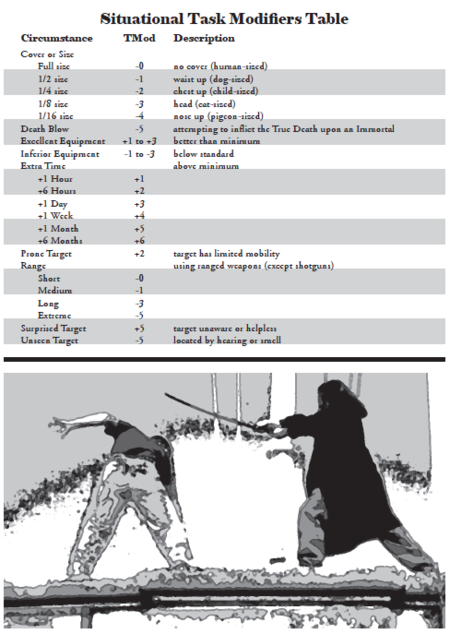
Whoops!
One of the things that
Vampire: the Masquerade
did very well was its Drama chapter, which gave rules for resolving situations besides combat that were difficult to adjudicate with just a single roll--car chases, trailing someone, interrogations, etc.
Legacy
doesn’t do this except for a few scenarios where the authors apparently believed that precise physical measurements were required. These rules are more focused on math than playability. They’re sparse, and weird about what they do want to focus on.

Nothing says Immortal Badass Swordsman like having to superimpose two guys fighting, because you couldn’t actually photograph them there, because the bellboys would run you off.
It devotes a whole page to calculating exact movement rates for characters who are running, climbing, swimming, or jumping, and has rules for falling damage that precisely measure distance and note terminal velocity. It even has a “velocity chart” that provides modifiers for when two characters are interacting but one of them is falling or speeding by in a vehicle. You just know that the one time in the campaign that two Immortals have a swordfight on top of two speeding cars, you’d just forget to look this up anyway. A car chase is one of the only specific scenarios besides combat that Legacy provides with specific rules, and they really just measure a car’s movement rate, how fast it accelerates and decelerates, and how much damage you take from car accidents.
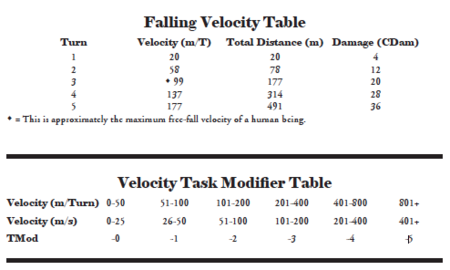
Combat
The combat rules use the same basic resolution as everything else. To attack, you make an Attribute+Skill+modifier roll. The important thing to remember is that your victim’s Dodge score is always a negative modifier to your attack, and your damage is reduced by their Strength. Actively rolling Dodge and Strength to reduce damage is not required.
Psychic attacks are hampered by Psychic Shield and Psyche instead of Dodge and Strength. On the one hand, if your enemy hasn’t invested in being a strong Psychic, his defenses will be mediocre. On the other hand, actually doing significant damage to anyone with Psychic attacks already incurs hefty penalties, which I covered in the last chapter.
In truth, the most striking thing about
Legacy
combat rules is what’s not there. A duel between Immortals is just handled as a standard fight. That may seem elegant, but it’s anticlimactic--although the base die mechanic is different, Legacy is fairly similar to the Storyteller system insofar as lethal combat is not likely to take more than a few rolls before someone dies. Even a “duel” in AD&D that consists of two fighters hacking away at each other until someone drops is likely to have more tension than an Immortal duel in Legacy, if only because it is likely to take more rolls with a more swingy die mechanic. For comparison, I believe that even
Legend of the Five Rings
, which is not a game all about swordsmen dueling, had special dueling rules because they recognized that such a thing has more tension and gravity than every attack in a melee.
The second most striking thing about the combat rules is that they seem to care more about guns than swords.

I am vengeance. I am the night. I...am...Photoshop 2.5!
Initiative
is determined by Agility. However, you can “force” your action if it’s purely defensive, like parrying. Actions don’t happen simultaneously, and if you’re moving and attacking, you have to move first.
Melee combat
gets a chart of tactical maneuvers. You can combine maneuvers into one action (such as a riposte that is also a tripping attack) but you only deal damage once, and all modifiers apply cumulatively. The melee maneuvers can be done with Fisticuffs or Melee Weapons; they work equally well for any kind of weapon.
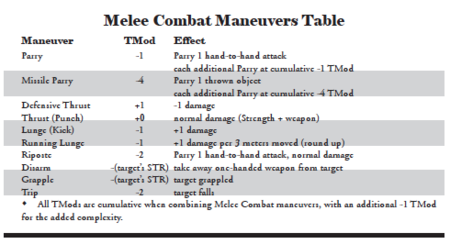
Parry
lets you negate an attack with an Agility+Melee roll. Once you start parrying, you can keep parrying all attacks against you for the rest of the turn, with a cumulative -1 modifier each time. (Missile Parry works the same way, but more difficult. It can parry slings and arrows, but not bullets, lasers, and explosions.)
Defensive Thrust
, Thrust, and Lunge require no explanation; they’re just modifiers to the stats of a basic attack.
Running Lunge
allows you to move and attack, with a penalty to hit and a bonus to damage.
Riposte
combines a Thrust and a Parry. It’s the most complicated maneuver, but only because it uses 1 roll to act as both the attack and defense. You can keep parrying after your initial parry and attack, but the modifiers stack up at -2 instead of -1.
Disarm
does what it says on the side of the box. When you disarm someone, it’s your choice if their weapon ends up in your hand or flung a few meters away.
Grapple
pins an enemy’s arms so that they take your Strength as a penalty to their actions. They can break out with a Strength+Melee/Fisticuffs roll, modified by your Melee/Fisticuffs skill.
Trip
knocks the enemy down. You get a bonus to attack a downed opponent.
You’re probably wondering if one sword is objectively the best--it must be the katana, right? Well, some swords are just better than others. There are no Strength requirements for weapons, and no rules for having a hand disabled unless it’s cut clean off, so there’s no reason not to use a big two-handed sword, which gives the best bonuses to attack and damage.
Legacy
blatantly rips off Storyteller's “pocket, jacket, trenchcoat, no way” rules for concealability.
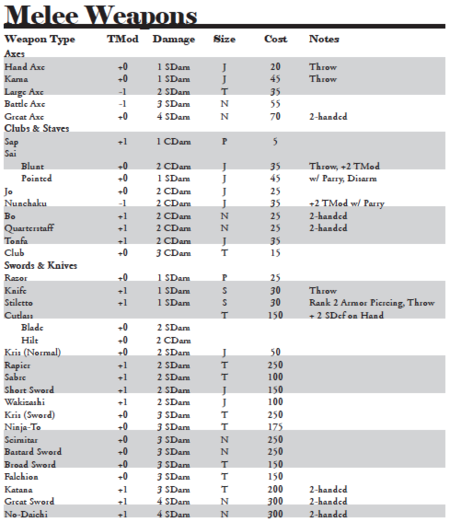

It’s not a 90s gothic game without pointless pictures of graveyard statues.
On the surface,
ranged combat
seems simpler than melee combat. It doesn’t have any special maneuvers, but there are autofire rules, “smart” weapon rules, and a huge chart of weapons and ammunition.
The autofire rules are really bad. With an automatic weapon, you can attack one target repeatedly, or fire an arc that hits multiple targets, with only a -1 cumulative penalty to each attack. What’s more, you only have to spend one bullet/shot on each attack! You only “lose” ammo if there’s empty space between multiple targets. It strikes me as very overpowered. You can even buy “recoil compensators” that negate the penalty on the first couple attacks!
Legacy
doesn’t have much in the way of CP202/Shadowrun style cyberware, but one thing it does have is “smartlinks.” They can they can control the cycle of fire on your weapons to prevent friendly fire while shooting multiple targets, and give you a +1 bonus. Fortunately, smartlinks require cybernetic implants that are almost impossible for Immortals, so at least when another Immortal decides to forgo the rules of honor and blast you repeatedly with a laser rifle, he won’t have a nifty targeting computer to make it even worse for you.
Explosive attacks, like grenades and rockets, work differently. Instead of aiming at a person, you aim at a hex, and everything in the blast radius takes damage. The Dodge skill is no help here, but if you fail, the explosive lands a random distance away, and explosives do less damage as you get further out from ground zero.
Oh, did I say “hex?” Yes, when it comes to ranged weapons, the rules start talking about “hexes” that haven’t been mentioned before. There is no apparent expectation that you use a hexmap; distances are given in meters when they matter at all. It’s a strange oversight.

Highlander: 40,000
Legacy
indulges in a 90s stereotype: the huge fucking chart full of guns. What’s more, some of them are laser and plasma weapons that do obscene damage. This really bothers me, because the game already provides only flimsy justifications for Immortals dueling with swords instead of guns. Why, if you use a plasma cannon to blow away an Immortal and steal his power, even more powerful Immortals will come after you! And they’ll be...challenging you openly, and...fighting honorably, and...armed only with swords and crappy psychic powers. Shit.



Oh well. On to
damage and healing
. Damage accumulates on a 10-point track, and there are two types of damage: Casual and Severe. Casual damage is done by fists and falls. Taking 10 Casual damage knocks you unconscious, and any damage after that becomes Severe. Falling out of an airplane does more than enough Casual damage to overflow both damage tracks and kill you. Severe damage is inflicted by weapons and fire and lightning bolts and shit, and taking 10 points will kill a mortal and knock an Immortal unconscious. Being wounded racks up action penalties quickly; there is a definite death spiral.
Your Strength Attribute always reduces damage from each attack; your Strength is your base Casual Defense and Severe Defense, which can be improved by armor.
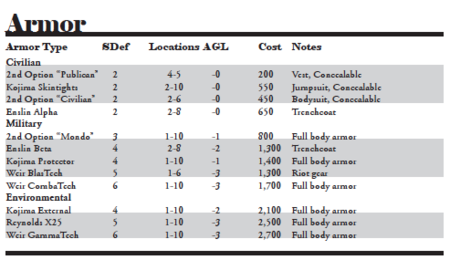
There is a
hit location system
which, at the GM’s option, can be rolled randomly or only invoked when someone takes a penalty to attack a specific body part. Dealing 5 severe damage to a limb is enough to cripple or sever it. The most important part of the hit location system is, of course, decapitation. This can only ever be done deliberately--even a lucky shot to the head that does massive damage will just dash your enemy’s brains out, not cleave their head from their shoulders. To decapitate someone, you take a -5 penalty to attack, and you need to deal 5 points of damage with a bladed weapon or 10 points of damage with a ranged weapon. (As I said before, the game is careful about specifying “severing the spine between the brain and the heart” instead of decapitation, but in practice it appears that they only understand that to mean hacking at your enemy’s neck.) This is one thing they get right, in terms of the Highlander show--you can pull this off with a lucky shot, but it’s best to do it after you’ve run your enemy through. (Or, you know, burnt him to a crisp with a plasma rifle.)
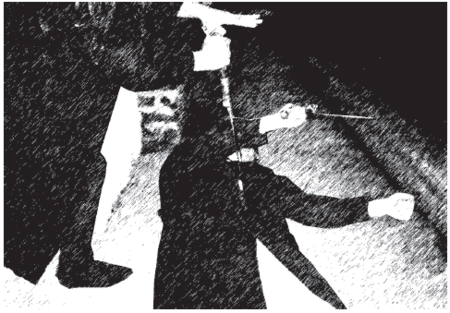
Who wants to play a game called “Bad
Legacy
Art or Smiths Album Cover?”
Healing is slow and fairly realistic. Mortals heal Casual Damage in hours and Strength damage in months; Immortals heal Casual damage in minutes and Severe damage in hours. There’s no Immortal mojo that will let you recover from crippling injuries in the middle of a fight. Nanotherapy can help people heal even faster, but it’s very expensive. It can even allow Immortals to accept cybernetic implants, but the therapy required is so expensive and so frequent that only the filthy rich could ever afford it.
That brings to mind another problem with the combat rules: Prices are equipment are given in credits, but there are no rules to adjudicate how you use your wealth or contacts to get ahold of expensive weapons and armor. It’s just assumed that all Immortals can live an affluent upper-middle-class lifestyle if they choose, and only a particular Accent allows you to essentially spend your points for cold hard cash.
Next time, on
Legacy
: Experience rules, and we wrap up the game with stats and advice on introducing enemies into the campaign.

Good, bad, I’m the guy with the gun, milady.
Unnecessary Evil
Original SA post
Hey, paisanos! I admit I’ve been slacking on my Legacy review. I assure you I’ve been reading all the stuff I’m working on concurrently, but getting married and moving house this year has really thrown a wrench in my plans to obsess over old games. I admit I’ve been lazy. It’s okay. Legacy is an incredibly lazy game.
Legacy Part 5: Unnecessary Evil
After Vampire: the Masquerade broke big, most roleplaying games from the 90s had a chapter devoted to “storytelling,” even ones that were really just about killing people and stealing their shit. Such chapters were about not only structuring and running adventures, but evoking the setting and introducing concepts like “theme.”
Legacy is definitely a game about killing people and stealing their shit. Like, literally soaking up their life force as it drains out of their headless corpse. But on top of that, its setting and theme is just Highlander with a thin coat of gothic-cyberpunk paint, so why bother? Instead there is just a very brief chapter on using experience points and a longer one for enemies.
Karma
Legacy calls its experience points “Karma,” and PCs must keep track of both unspent Karma and the total Karma earned. This also matters for NPCs--when one Immortal beheads another, they get 1/10th of that Immortal’s total earned Karma. If the GM is playing by the book, Legacy is otherwise pretty stingy with Karma, and increasing Stats and Abilities is pretty expensive. Dueling fellow Immortals is an important source of experience.
Let me remind you that the PCs’ fellow “Post-Modern” Immortals will have zero earned Karma, Moderns 100, Medieval 200, Imperials 300, and Ancients 400. So even killing an ancient Immortal bogeyman whispered of in legends doesn’t net you that much Karma in and of itself--it’s not comparable to, say, diablerizing an elder Kindred in Vampire .
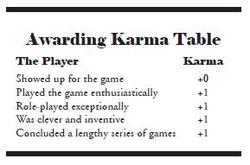
I’ve never seen a game come right out and say that 0% of success is showing up.

”I just have to chop off another dude’s head, then I can be superhumanly good at driving boats!”
Legacy highly discourages players from just putting points in stuff because they want it. No, you have to justify how your training yourself to be better at fighting or tracking or speaking French. This is pretty weird in a game that explicitly tells you that you’re gaining knowledge and power by stealing somebody’s life-force.
Anyway, Legacy kinda screws itself out of its “earned Karma” rules making sense, because you can spend 1 point of Karma to improve your roll by 1 point (or penalize your enemy’s roll). Unlike Shadowrun, for example, which also calls experience Karma and uses your total Karma as a “luck stat” that you can invoke, Karma spent this way is just lost. You should never spend Karma this way unless it’s life-or-death, as it means you are proportionally weaker than another Immortal with the same total Karma, and other Immortals can sense your Karma level and will come gunning for you based on that. This design decision, to let PCs spend experience points for a temporary bonus, was once rampant but is mostly abandoned today.

This book has a lot less ponytail than Highlander, and a lot more neckbeard.
Necessary Evil
Legacy provides you with descriptions and statblocks for NPCs who will team up with you, fight you, laugh at your trenchcoat-and-sneakers outfit, and so on. Mortals, Immortals, Warlocks, Nosferatu, Dwimmerlaik...
Wait. Vampires and wizards and what? Yes, they’re a part of the Legacy settting, and no, I haven’t mentioned them before. I believe the book did mention some of them in that initial setting chapter, but it does so totally out of context, without explaining itself, and with no detail whatsoever on how these various things-what-go-bump-in-the-night affect the world. The simple answer is that they don’t. Just as there’s little or no detail on how AIs and holo-phones are supposed to affect your PCs’ daily lives, these monsters are just things for you to fight in-between duels with other Immortals.
Mortals : Although Duncan MacLeod tangled with drug dealers, terrorists, assassins, vigilantes, and vengeful businessmen over the course of the series, Legacy doesn’t bother to give you any ideas as to why mortal organizations would make trouble for a superhuman serial killer like yourself. Instead, it suggests that “powerful enemies” might use mortals as pawns to wear you down. We’re given statblocks for a Police Officer, Kung Fu Master, Psychic, Shock Trooper, and strangely, average mortals in “Sedentary” and “Active” varieties. Y’know, just in case the party wants to stop an evil fantasy football league, then work their way up to fighting church softball teams.

”So you’re Immortal, huh? Well la-dee-freakin’-dah ! You’ll have plenty of time to be prince of the universe when you’re livin’ in a van down by the river !
Immortals : We’ve covered this already. That said, this section provides statblocks for a Modern, Medieval, etc. Immortal for you to use. (I’m not sure why it matters that the Modern Immortal has the Animal Training skill.) Ancient Immortals are supposed to be legendary to the point that no one knows if any still exist--a neat trick, considering that Immortals can sense others nearby, and sense their approximate power level.
Nosferatu : Vampires are the best-known monsters out there, since they hang around with mortals. They’re created by a mystical disease that kills a person’s body but strengthens their life-force, allowing it to animate their corpse. Nosferatu are strong and tough (their Body stat soaks Severe damage as well as Casual damage), and they have formidable psychic powers. Stories of vampires turning into mist and animals can be chalked up to clever uses of the Illusion power, but rare vampires do have powers that transcend the Psychic abilities available to Immortals. Vampires wouldn’t be much of a threat--they only need about a liter of human blood per week to survive--but to them, Immortal blood is really good stuff. It makes them stronger and nourishes them for a long time. Brief exposure to sunlight weakens them; prolonged exposure kills them within hours.
Chimerae : I have to give Legacy credit: Chimerae are genuinely weird and different. They’re carnivorous shapeshifters who have to eat their prey alive, and they can mimic the handful of creatures--generally people--they’ve most recently eaten. They absorb enough of their victim’s memories to mimic their behaviour fairly well; in effect, it acts as the Mask Psychic Ability at 5, although their physical form does actually change.
Their method of feeding is to isolate a victim, knock them unconscious, and swarm over them as a consuming blob. They have to consume their own weight in live prey every moon-cycle, or they begin to painfully starve as their mass melts away over the course of weeks and months. Chimerae are really hard to kill, since anything you cut off acquires a life of its own and starts crawling around. In practice, they simply don’t take damage from things besides fire and acid, which I think is a bad way of handling it. A hacked-up heap of body parts doesn’t sound that dangerous. They probably just wanted an antagonist that Immortals can’t kill with swords and guns.
Dwimmerlaik : Dwimmerlaik are the weirdest. No one knows where they come from; they seem to come from outside our reality. They can look like anything, from people to Lovecraftian tentacled horrors, but what they all have in common is a hatred of all life and the ability to warp reality around them. (Similar to the Chimerae, all Dwimmerlaik have the Illusion power, except that the changes they make are real and permanent. Fortunately, directly warping someone’s body carries a huge penalty.) They’re incredibly tough--all damage is halved even before their Defense is applied--and their only weakness is sunlight, which hurts them but doesn’t do any actual damage.
Warlocks : Warlocks are humans with reality-warping powers like the Dwimmerlaik; most are Psychic as well. Almost all of them have been driven at least a little crazy by their powers and the things they’ve learned. Warlocks aren’t technically Immortal, but many of them have used magic to prolong their lives for centuries, and they often scheme against each other as well as observing Immortals from afar. Real talk: Legacy: War of Ages was meant to be accompanied by a game called Warlock: Black Spiral , with Warlocks playing Merlin to Immortals’ King Arthur. I don’t believe Warlock was ever physically published, although for a time it was available for free on the authors’ website. There’s a brief review of it here .

These guys beat Instagram to the punch on “buying crap online and putting filters over it.”
The System Mastery fellows have inspired me to do a bit of postmortem on the games I review. So what do I think of Legacy: War of Ages ?
The best thing? Probably the best thing I can say about this game is that it keeps things simple when it comes to handling supernatural powers. Immortals, mortal psychics, and monsters and wizards all use the same set of powers which are, in turn, assimilated into the skill system instead of marked out as a complex “magic system.”
The worst thing? I have to admit, I kind of admire their gall for just blatantly ripping off an established property. But Legacy ’s biggest sin is that it doesn’t do anything to make the premise of Highlander more playable. Let’s face it, there are a lot of campaigns, and even a lot of published games, that are basically “like X” or “like X but with Y.” Highlander is a prime example of a sci-fi/fantasy movie that just does not translate well to a roleplaying game, no matter how hard people have tried. Both the movies and the series are about a lone hero fighting one-on-one duels to the death, in a round-robin tournament that only one guy can ultimately win. His supporting cast is not as effective or meaningful as, say, Buffy ’s crew of “Scoobies.” They could have changed the mythology of Highlander to allow groups of Immortals fighting common enemies, and introduced a better endgame than “there can be only one.” Instead, Legacy is literally just Highlander with the names of things changed to be more grandiose, set in a laughably bare-bones cybergoth future.
Would I play it? Maybe a one-shot, for a laugh. But at the table, there isn’t even much to laugh at.
Would I run it? Absolutely not. Legacy ’s worst sin is giving you no reason to play the setting, but its second-worst sin is giving you no reason to play with these rules. As a published Highlander game, it’s mediocre because there are already free homebrews for playing Highlander in Storyteller, GURPS, Unisystem, D20, and other systems, which have been floating around the Internet since Geocities was a thing. Fuck, I even remember reading some guy’s Chill page where they’d houseruled Highlander style immortals as PCs. As a game in its own right, Legacy does nothing to distinguish itself among the legion of bland Stat+Skill+(generic resolution method) games that have come and gone over the years. So, even if you specifically want to play "Highlander, but cyberpunk and with vampires" it's about as easy to use a preexisting game as to use this one. Like the Backstreet Boys and novelty top hats, Legacy is a totally unnecessary and totally unoriginal product of the 90s.